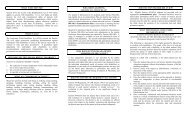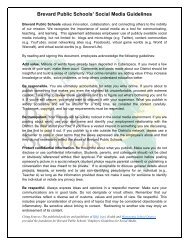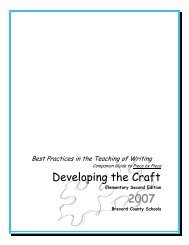Developing Artistic Writing.pdf - Brevard Public Schools
Developing Artistic Writing.pdf - Brevard Public Schools
Developing Artistic Writing.pdf - Brevard Public Schools
You also want an ePaper? Increase the reach of your titles
YUMPU automatically turns print PDFs into web optimized ePapers that Google loves.
Crazy Sayings<br />
Objective: Students will identify an idiom and draw a literal illustration to match and an<br />
illustration that shows the intent of the idiom.<br />
Anticipatory Set: Read Amelia Bedelia pointing out the idioms throughout the book. Discuss<br />
and record idioms from the book and idioms that the students have heard.<br />
That caught my eye. It’s raining cats and dogs. He was under the weather.<br />
Does the cat have your tongue? This car can turn on a dime. My feet are on fire!<br />
Don’t beat around the bush. We’re down to the wire. They are dropping like flies.<br />
That’s the icing on the cake. It’s a small world. He knows the ropes.<br />
Make no bones about it. He’s on the fence. Don’t pig out. This is a piece of cake.<br />
See www.idiomsite.com for more examples<br />
Modeling: Fold a piece of paper lengthwise (hot dog) and write “Get the lead out,” across the<br />
top of the paper explaining that this idiom means to hurry and get going. Draw a picture on the<br />
left column that literally shows a character picking up a piece of lead and hauling it away, then<br />
on the right side of the paper, draw a picture of someone hurrying. Across the bottom write the<br />
explanation of the idiom, “to hurry and get going.” In this way the students see the literal and<br />
figurative interpretation of the idiom.<br />
Guided Practice: Students select another idiom. Follow the same steps as above, except this<br />
time the students weigh in on what to draw on each side. With student input, draw the illustration<br />
described (both the literal and figurative meaning of the idiom).<br />
Independent Practice: Students select an idiom for themselves. This can be assigned by the<br />
teacher, decided by the student, or drawn at random. Working independently, the students create<br />
their own page, folding the paper in half, illustrating each side, writing the idiom across the top,<br />
and writing the explanation of the idiom across the bottom.<br />
Publishing/Sharing: Students collate their pages into a class book on idioms.<br />
6













